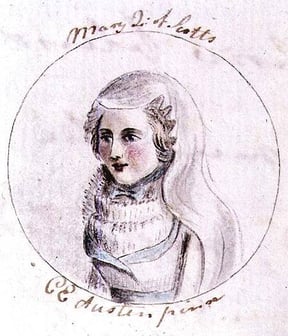Lovers of Jane Austen are lucky. Few other authors have left behind a greater wealth of juvenalia. From the ages of 11 to 18, Austen filled three notebooks with stories, parodies, mini-plays, and more, all displaying the shrewd wit and intelligence that would later blossom into genius. Among the shining examples of her earliest work is a short, satirical piece titled The History of England, written when the author was only 15 years old.
 Austen was an autodidact, a thoroughly critical person who struck a love affair with books and literature at an early age, and all of this is reflected in her juvenalia. It makes sense, as a child who was mostly home-schooled and taught by her parents’ library, that much of her teenage work is sharply humorous and playful. She noticed the faults of those works that commanded her attention and was adept at exposing their faults. Take this mini-play, called “The Mystery,” which pokes fun at the theatre’s reliance on secrets, raising it to comic heights by never revealing what it is everyone’s talking about:
Austen was an autodidact, a thoroughly critical person who struck a love affair with books and literature at an early age, and all of this is reflected in her juvenalia. It makes sense, as a child who was mostly home-schooled and taught by her parents’ library, that much of her teenage work is sharply humorous and playful. She noticed the faults of those works that commanded her attention and was adept at exposing their faults. Take this mini-play, called “The Mystery,” which pokes fun at the theatre’s reliance on secrets, raising it to comic heights by never revealing what it is everyone’s talking about:
Daphne: My dear Mrs Humbug, how d'ye do? Oh! Fanny, t'is all over.
Fanny: It is indeed!
Mrs Humbug: I'm very sorry to hear it.
Fanny: Then t'was to no purpose that I ....
Daphne: None upon Earth.
Mrs Humbug: And what is to become of? ..... (whispers Mrs Humbug)
Daphne: Oh! that's all settled.
In 1791, at the age of a high school sophomore, Austen turned her parodic gaze to the educational books of her day, namely Oliver Goldsmith’s four-volume textbook, called The History of England. Books of this sort were known for reducing history to rote, digestible, and nuance-free trivia and for injecting their subject matter with the partisan biases and opinions of the author. The young Jane Austen wrote in the margins of her own copy, revealing precocious opinions. “A family who were always ill used Betrayed or neglected,” she said of the portrayal of the Stuarts, “whose virtues are seldom allowed while their errors are never forgotten.”
 Jane Austen teamed up with her sister Cassandra (who illustrated 13 portraits of the monarchs, like the one above) to compose a 3,500 word parody of the history textbooks of her day, purportedly written by a “partial, prejudiced, & ignorant Historian.” Such is but one of many effective jokes in a piece decorated by a sharp sense of humor. Austen’s historian writes of James I, son of Queen Elizabeth: “Though this King had some faults, among which & as the most principal, was his allowing his Mother's death.” Still, our biased chronicler admits (irrelevantly) that “considered on the whole I cannot help liking him.”
Jane Austen teamed up with her sister Cassandra (who illustrated 13 portraits of the monarchs, like the one above) to compose a 3,500 word parody of the history textbooks of her day, purportedly written by a “partial, prejudiced, & ignorant Historian.” Such is but one of many effective jokes in a piece decorated by a sharp sense of humor. Austen’s historian writes of James I, son of Queen Elizabeth: “Though this King had some faults, among which & as the most principal, was his allowing his Mother's death.” Still, our biased chronicler admits (irrelevantly) that “considered on the whole I cannot help liking him.”
Like a great satirist, Austen balances the ambivalent feelings of care for her subject and disappointment in how it is often treated. Each one of her royal portraits, spanning from Henry IV to Charles I (years 1367–1649), betrays an attuned knowledge of England’s rulers, their legacies, and their associates.
Jane Austen’s early work was not released during her lifetime. Instead, it was passed down three generations from Cassandra Austen. A descendant allowed the notebooks to be published in 1922. Just over 50 years later, it was sold to the British Library, which provides a digital version of the illustrated manuscript online. It is worth taking a look at and reading, as a true document of a creative spirit that seized on the earliest opportunity to show itself.









